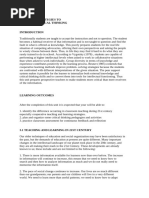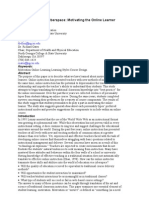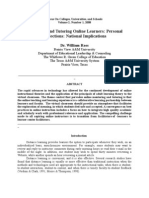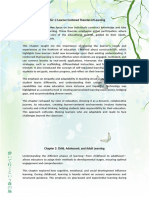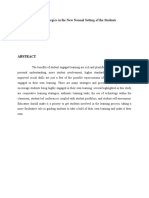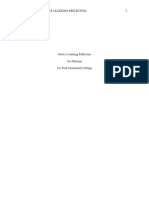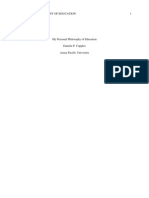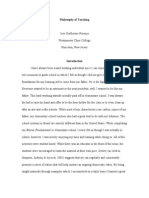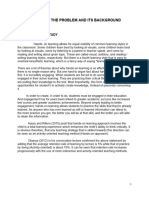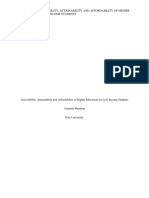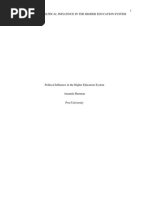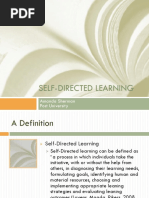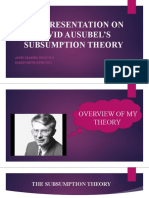0 ratings0% found this document useful (0 votes)
Unit 8 Final
Unit 8 Final
Uploaded by
api-310891073This document discusses misconceptions about adult learning. It begins by explaining that traditional views of college students are outdated due to changes in higher education. It then addresses three main misconceptions: that self-directed learning simply means being motivated rather than having specific techniques; that informal learning has little value; and that multi-generational classrooms don't impact instruction. The document provides details refuting each misconception through research findings and examples. It emphasizes that adult learning is complex with value occurring both inside and outside the classroom.
Copyright:
© All Rights Reserved
Available Formats
Download as DOCX, PDF, TXT or read online from Scribd
Download as docx, pdf, or txt
Unit 8 Final
Unit 8 Final
Uploaded by
api-3108910730 ratings0% found this document useful (0 votes)
This document discusses misconceptions about adult learning. It begins by explaining that traditional views of college students are outdated due to changes in higher education. It then addresses three main misconceptions: that self-directed learning simply means being motivated rather than having specific techniques; that informal learning has little value; and that multi-generational classrooms don't impact instruction. The document provides details refuting each misconception through research findings and examples. It emphasizes that adult learning is complex with value occurring both inside and outside the classroom.
Original Title
unit 8 final
Copyright
© © All Rights Reserved
Available Formats
DOCX, PDF, TXT or read online from Scribd
Share this document
Did you find this document useful?
Is this content inappropriate?
This document discusses misconceptions about adult learning. It begins by explaining that traditional views of college students are outdated due to changes in higher education. It then addresses three main misconceptions: that self-directed learning simply means being motivated rather than having specific techniques; that informal learning has little value; and that multi-generational classrooms don't impact instruction. The document provides details refuting each misconception through research findings and examples. It emphasizes that adult learning is complex with value occurring both inside and outside the classroom.
Copyright:
© All Rights Reserved
Available Formats
Download as DOCX, PDF, TXT or read online from Scribd
Download as docx, pdf, or txt
0 ratings0% found this document useful (0 votes)
Unit 8 Final
Unit 8 Final
Uploaded by
api-310891073This document discusses misconceptions about adult learning. It begins by explaining that traditional views of college students are outdated due to changes in higher education. It then addresses three main misconceptions: that self-directed learning simply means being motivated rather than having specific techniques; that informal learning has little value; and that multi-generational classrooms don't impact instruction. The document provides details refuting each misconception through research findings and examples. It emphasizes that adult learning is complex with value occurring both inside and outside the classroom.
Copyright:
© All Rights Reserved
Available Formats
Download as DOCX, PDF, TXT or read online from Scribd
Download as docx, pdf, or txt
You are on page 1/ 11
Misconceptions of Adult Learning and Application Synthesis
Page 1
Amanda Sherman
Post University
Misconceptions of Adult Learning and
Application Synthesis
Misconceptions of Adult Learning and Application Synthesis
Page 2
Introduction
The landscape of adult learning in higher education has dramatically changed over the past few
decades, leading to many misconceptions in todays culture. The traditional norms associated
with college students are now considered antiquated. So who is the modern day adult learner?
Uncovering the answer to this question may start by addressing some misconceptions of adult
learners. The first misconception I held regarding adult learners is in reference to self-directed
learning. I had heard many times that adult learners were self-directed, that characteristic
specifically is one thing which differentiated them from youths. However, I had very little
information about what a self-directed learner was. I thought it was merely an adjective, one I
associated with driven, self-starter or motivated. My opinion now has been dramatically
changed. I see self-directed learners hold specific qualities and there are certain techniques
associated with self-directed learning. There is even empirical research upon the subject.
A second misconception I had prior to my research was that informal and non-formal
learning held little value, or vocationally specific value. The only non-formal educational
experience I have encountered myself is within the workplace. Therefore I had held a strong
association with non-formal learning experiences with job training and development. Outside of
that use I saw very little need for non-formal education other than for entertainment or
recreation. After reviewing the different styles and topics of informal learning environments, and
researching scholarly works on the subject I have come to view informal education as valuable
and an integral aspect of adult development.
Finally, the effect of multi-generational classrooms or blended age-groups was a topic I
previously considered to have very little impact on both the professor and the classroom. In
Misconceptions of Adult Learning and Application Synthesis
Page 3
reality teachers must adjust their instruction to adapt to mixed-age classrooms, and be aware of
the dynamics within the classroom themselves. Students from different generations tend to have
misconceptions of each other which can impede their ability to work together cohesively. It has
become apparent to me that age within the classroom is a significant factor.
Self-Directed Learning
Prior to learning about the study of self-directed learning, I was under the impression that selfdirected learning was simply an adjective labeling adult learners as proactive and self-driven.
Upon further research, I now understand that self-directed learning encompasses many learning
strategies and techniques. Knowles concept of self-directed learning is a process in which
individuals take the initiative, with or without the help of others, in diagnosing their learning
needs, formulating learning goals, identifying human and material resources for learning,
choosing and implementing appropriate learning strategies and evaluating learning outcomes
(Smith, 2016, p1). Immediately upon definition self-directed learning can be seen as more than a
mere adjective. It centers on self-evaluation and self-discovery, along with initiative and
independence. In a study conducted to find what self-directed teaching strategies students felt
most comfortable with, students were asked to rank strategies on a scale of 1-10, ten being most
comfortable, 1 being least comfortable. The full results are depicted in Table 1, they indicate that
students are most comfortable with self-evaluation and flexible due dates and are least
comfortable with choice of paper topics and student led discussions (Cox, 2015). Students are
clearly comfortable charting their own course in their learning experience, and they are even
aware of how they prefer teachers to grant them independence within their classrooms.
Misconceptions of Adult Learning and Application Synthesis
Page 4
It is a misconception that teaching strategies to promote self-directed learning must be
fluid or without boundaries. Giving the students complete freedom within their learning
environment. Some effective strategies include: introducing activities that focus on increasing
confidence, including appropriate skill development activities, asking previous students to talk to
the class, including appropriate skill development activities, demonstrating these activities to the
class (Smith, 2016, p4). An example of this may be that in an instructor wishes for the class to
create a business proposal for a start-up company, to give them multiple examples of previous
student work, or work that is available through a collective educational community online. This
allows the student independence in their project, but also inspiration and resources to draw upon
for guidance.
Informal Learning
Prior to exploring informal and non-formal learning, I held the misconception that
informal learning held little value academically. When thinking of informal adult learning, the
thought of community centers with sewing circles or movie nights came to mind. After
researching an actual adult education program, I found that there is much more to informal adult
education. Courses can have academic meaning such a GED testing or SAT prep, they can have
vocational development such as real-estate licensure classes, they can be life skills training such
as infant CPR, and of course there are also courses for mere entertainment such as day trips to
New York City. But informal learning does not just take place in these somewhat organized
settings, it takes place throughout our daily lives through access to the internet, social media
television and through peers in workplaces. Informal learning is life-long learning. A
development which never ceases.
Misconceptions of Adult Learning and Application Synthesis
Page 5
Integrating informal leaning techniques into the classroom can be extremely valuable. In
a study conducted with students in a MESA, or Math, Engineering and Science Achievement
program, the participants were asked open-ended questions about their favorite experiences and
what they believe they gained from the informal learning experience. The results yielded eight
themes: informal mentoring, makes learning fun, time management, application of math and
science, feelings of accomplishment, builds confidence, camaraderie and exposure to new
opportunities (Denson, Stallworth, Hailey & Householder, 2015, p12). Many of these positive
reactions are tied specifically to the style of instruction. Informal mentoring, making learning
fun, camaraderie, these are all unique to a learning format that is less structured and more
collaborative. Informal learning not only has merit outside of the classroom, but it is a style of
learning that can be integrated within a classroom setting with constructive outcomes.
There are many benefits to informal learning. They can be found at the individual level,
by improving their meta-cognitive skills (learning to learn); increasing their self-confidence;
improving their social skills (Cullen, Batterby, Foresti, Lyons & Stern, 2000, p12). At the
institutional level, informal learning can promote cohesion and social integration (Cullen, et. al,
2000). An example would be a company who wishes to cultivate a unified workforce may hold
seminars and job development training. Not only does informal learning benefit the individual,
but it benefits the workplace and society as a whole. The development of our culture relies on
the desire of individuals to continually better themselves and to contribute to their environments
through the acquisition and application of new information.
In a classroom setting, informal learning can be seen through mentoring. Pairing students
with diverse perspectives provides the opportunity for a growing experience. It is a chance to
learn approaches to the material in a casual setting from someone who is considered their peer.
Misconceptions of Adult Learning and Application Synthesis
Page 6
Students typically feel more comfortable raising questions within these formats, and may even be
more open to learning new techniques.
Multi-Generational Classrooms
It has always been clear to me that the growing popularity of online classrooms and
growing competition in the American job market, has made returning to school at later ages more
common. Leading to an age-diverse classroom. However, I had never considered that the
differences within these students may change the dynamics of the classroom. And in turn effect
the style of teaching necessary to communicate with such a diverse age group.
With the rise in older adult learners within higher education settings, has come a shift in
the classroom dynamic. First, is the students perceptions of each other. It is easy for students to
look around a classroom and make a quick baseless misconception of another student based upon
their age. Second, is the teachers attitudes toward the class, and teaching strategies used. Does
the teacher treat every individual student the same? Or do they treat students of different ages
differently? The teacher must also be aware of the dynamics developing within their classroom,
and apply techniques that hopefully will increase classroom cohesion. Faculty should be aware
of the attitudes and inclinations toward learning prevalent in their classrooms and be open to
developing methods and strategies that will benefit the learning environment for students of all
ages (Donavant, Daniel, & MacKewn, 2013, p134). Hayslip, Neumann, Lauden and Chapman
(2006) look at Levinsons age-graded theory; the traditional college student is in the Early Adult
Transition phase (ages: 17-22) (p.125). They are still in a state of pre-adulthood, finding their
role in the world and developing relationships. Older adult learners may fall into one of the other
transition phases: Entering The Adult World, The Age Thirty Transition, The Midlife Transition,
Misconceptions of Adult Learning and Application Synthesis
Page 7
The Age Fifty Transition, or anywhere in between (Hayslip, et. al., 2006). Teachers and students
alike must adapt to these changing classroom climates, and much like having cultural sensitivity,
learn age-sensitivity. Taking into account what stage of life a person may be in, and the effect
that may have on their attitudes as a student.
Studies have been conducted to shed light on the attitudes of students in mixed age
classrooms regarding their peers and their perceptions of their professors interactions with their
peers. In a study conducted at six undergraduate Tennessee institutions, faculty was surveyed to
determine their attitudes toward mixed-age classrooms. Overall it was found that 88% of the
faculty disagreed that having adult students in class inhibited traditional students participation;
likewise 84% did not believe that traditional students inhibited adult students from participating
in the class (Donavant, et. al., 2013, p137). It was also found that 69% of faculty thought that
adult learners exhibited greater intrinsic motivation and 60% believed adult learners worked
harder on their studies (Donavant, et. al., 2013). So although it was found that professors do not
believe that age differences negatively affect the classroom environment, it was also shown that
professors can hold the bias that older learners tend to be more conscientious students.
A second study surveyed 320 students on the two campuses of Miami University. In
regard to the relationship between older students and the professor, 64% of the students
perceived that older students treat their professor as a friend (Lynch, & Bishop-Clark, 1994).
However, it was reported that only 11% of younger students and 17% of older students preferred
to be in classrooms with students their own age, an overwhelming 98% of students surveyed
stated that they enjoyed the diversity of a mixed age classroom (Lynch & Bishop-Clark, 1994).
It is clear that although multi-generational classrooms can lead to challenges in teaching
Misconceptions of Adult Learning and Application Synthesis
Page 8
techniques and classroom cohesion, the benefits of blending the cohorts is valued by both
generations.
When addressing a multi-generational classroom, the professor must always be aware of
the social balance. They must notice if the older leaners are isolating themselves from the class,
or if the younger learners are devaluing the contributions of the older learners, for instance. One
way to break down the age barriers is to assign a group project specifically with small, agediverse groups. Within a more intimate setting the students have the opportunity to discover
what the other generation has to offer, and allows for mentoring and collaboration.
Conclusion
Prior to taking this class I held many misconceptions about the adult leaner. I was
familiar with the characteristics of the adult learner, and the struggles that they face. I had even
developed strategies to combat attrition and studied motivational techniques. The weakest aspect
of my understanding was what the educational experience actually was for the adult learner.
Gaining a perspective on the meaning of self-directed learning proved incredibly valuable.
Especially concerning the techniques instructors can utilize to promote self-directed learning.
That although self-directed learning is internally motivated, it can be externally influenced.
Learning how informal learning takes place and the value behind it, gave me insight on the adult
learning process. How learning is taking place throughout our entire lifetime, and that those
informal techniques can be brought into the classroom to encourage creativity and discovery.
Finally researching the effects of multi-generational classrooms had a tremendous impact on how
I view the climate of todays classroom and the sensitivity needed to instruct such a diverse
population. Being aware of how students interact with each other, and their perceptions of the
Misconceptions of Adult Learning and Application Synthesis
Page 9
professors interactions with differing generations. With confidence, I can say that my
understanding of the educational experience of the adult learner had been broadened and shaped
by my studies through this course.
Misconceptions of Adult Learning and Application Synthesis
Page 10
References
Cox, T. D. (2015). ADULT EDUCATION PHILOSOPHY: THE CASE OF SELF-DIRECTED
LEARNING STRATEGIES IN GRADUATE TEACHING. Journal Of Learning In Higher
Education, 11,(1), 17-22.
Cullen, J., Batterbury, S., Foresti, M., Lyons, C., & Stern, E. (2000). Informal learning
and widening participation. Research Brief, 191.
Denson, C. D., Stallworth, C. A., Hailey, C., & Householder, D. L. (2015). Benefits of
Informal Learning Environments: A Focused Examination of STEM-based Program
Environments. Journal Of STEM Education: Innovations & Research, 16 (1), 11-15.
Donavant, B. B., Daniel, B. V., & MacKewn, A. S. (2013). (Dis)connected in Todays
College Classroom? What Facult Say and Do About Mixed-Age Classes. Journal Of Continuing
Higher Education, 61(3), 132-142. Doi:10.1080/07377363.2013.836811
Hayslip Jr, B. E. R. T., Neumann, C. S., Louden, L., & Chapman, B. (2006).
Developmental stage theories. Comprehensive handbook of personality and psychopathology,
115.
Lynch, J., & Bishop-Clark, C. (1994). The Influence of Age in College Classrooms:
Some New Evidence. Community College Review, 22(3), 3-12.
Smith, T. (2015). Self-Directed Learning. Research Starters: Education (Online Edition),
Misconceptions of Adult Learning and Application Synthesis
Page 11
Table 1
Teaching Strategy
Choice of Paper Topics
Student Led Discussions
Choice of Assignments
Service Learning
Group Presentations
Role Play
Individual Presentations
Self-Paced Assignments
Flexible Due Dates
Self-Evaluation
(Cox, 2015, p20)
Mean
2.86
3.01
4.48
4.63
5.19
6.43
6.75
6.75
7.33
7.50
You might also like
- Teacher Strategies in critical thinkingNo ratings yetTeacher Strategies in critical thinking23 pages
- Learning Styles of Grade 4 Pupils in Apsayan Elementary SchoolNo ratings yetLearning Styles of Grade 4 Pupils in Apsayan Elementary School34 pages
- Radical Educational Strategies For New Generations Rev JMT100% (1)Radical Educational Strategies For New Generations Rev JMT8 pages
- Coping Strategies in The New Normal Setting of The StudentsNo ratings yetCoping Strategies in The New Normal Setting of The Students6 pages
- Classroom-Ready Resources for Student-Centered Learning: Basic Teaching Strategies for Fostering Student Ownership, Agency, and Engagement in K–6 ClassroomsFrom EverandClassroom-Ready Resources for Student-Centered Learning: Basic Teaching Strategies for Fostering Student Ownership, Agency, and Engagement in K–6 ClassroomsNo ratings yet
- Andragogy: A Theory in Practice in Higher EducationNo ratings yetAndragogy: A Theory in Practice in Higher Education17 pages
- Read Research or Study Related To Learner-Centered Psychological Principles (LCP)100% (2)Read Research or Study Related To Learner-Centered Psychological Principles (LCP)3 pages
- Essay On How Can I Be A Progressivist Teacher100% (1)Essay On How Can I Be A Progressivist Teacher5 pages
- Handout - Learner & Learning Process M.ed II SemesterNo ratings yetHandout - Learner & Learning Process M.ed II Semester103 pages
- Running Head: Misconceptions in Adult Learning 1No ratings yetRunning Head: Misconceptions in Adult Learning 18 pages
- COMMITMENT TO CONTINUOUS IMPROVEMENT An Action Research Study of Teaching Methods in My Beginning Spanish I College ClassroomNo ratings yetCOMMITMENT TO CONTINUOUS IMPROVEMENT An Action Research Study of Teaching Methods in My Beginning Spanish I College Classroom53 pages
- Engaging Students in The Global ClassroomNo ratings yetEngaging Students in The Global Classroom13 pages
- HMEF5073 Curriculum Development September 2018 Semester100% (1)HMEF5073 Curriculum Development September 2018 Semester19 pages
- For Online Learning Design That The Particular Needs of The Adult Learner Have To Be PrioritizedNo ratings yetFor Online Learning Design That The Particular Needs of The Adult Learner Have To Be Prioritized4 pages
- Personal Approach To Classroom ManagementNo ratings yetPersonal Approach To Classroom Management13 pages
- Autonomy & Motivation in Distance Learning: Robert・CVITKOVIC, Yoshie SakamotoNo ratings yetAutonomy & Motivation in Distance Learning: Robert・CVITKOVIC, Yoshie Sakamoto0 pages
- Principles and Teaching Methods of Andragogy: Dr. Radhika KapurNo ratings yetPrinciples and Teaching Methods of Andragogy: Dr. Radhika Kapur14 pages
- Enrichment Clusters: A Practical Plan for Real-World, Student-Driven LearningFrom EverandEnrichment Clusters: A Practical Plan for Real-World, Student-Driven Learning5/5 (1)
- Connecting Readers to Multiple Perspectives: Using Culturally Relevant Pedagogy in a Multicultural ClassroomFrom EverandConnecting Readers to Multiple Perspectives: Using Culturally Relevant Pedagogy in a Multicultural ClassroomNo ratings yet
- Running Head: STRATEGIC PLAN Assessment 1No ratings yetRunning Head: STRATEGIC PLAN Assessment 111 pages
- EDU 515 Data Driven Decision Making Project Other EnvironmentsNo ratings yetEDU 515 Data Driven Decision Making Project Other Environments6 pages
- Application of The Mental RepresentationsNo ratings yetApplication of The Mental Representations8 pages
- Unit 8 Final Misconceptions in Adult LearningNo ratings yetUnit 8 Final Misconceptions in Adult Learning10 pages
- A Study of Post University Fol 3 5 2016No ratings yetA Study of Post University Fol 3 5 201615 pages
- Allama Iqbal Open University, Islamabad (Department of English Language and Applied Linguistics) WarningNo ratings yetAllama Iqbal Open University, Islamabad (Department of English Language and Applied Linguistics) Warning2 pages
- FAMORCAN, MAVELLE A. - WEEK 7 PERSONAL DEVELOPMENT - gRADE 11No ratings yetFAMORCAN, MAVELLE A. - WEEK 7 PERSONAL DEVELOPMENT - gRADE 115 pages
- E-Sim Electronic Strategic Intervention MaterialNo ratings yetE-Sim Electronic Strategic Intervention Material20 pages
- How To Keep High Achievers Engaged and Motivated RenzulliNo ratings yetHow To Keep High Achievers Engaged and Motivated Renzulli1 page
- UNLV/Department of Teaching & Learning Elementary Lesson Plan TemplateNo ratings yetUNLV/Department of Teaching & Learning Elementary Lesson Plan Template3 pages
- 2021-09-01 Iped Lesson Plan Template-2 Mclinn Stocker Elementary 1 - MergedNo ratings yet2021-09-01 Iped Lesson Plan Template-2 Mclinn Stocker Elementary 1 - Merged10 pages
- Step 1: Create A Technology-Integrated Lesson PlanNo ratings yetStep 1: Create A Technology-Integrated Lesson Plan5 pages
- FS 2 - Episode 6 Deductive and Inductive Methods of TeachingNo ratings yetFS 2 - Episode 6 Deductive and Inductive Methods of Teaching7 pages
- The Teacher and School The Curriculum: Prepared byNo ratings yetThe Teacher and School The Curriculum: Prepared by8 pages
- Reference: Deped Order No. 42, S. 2016: Ticulon Nhs Grade 11 Janice S. AlquizarNo ratings yetReference: Deped Order No. 42, S. 2016: Ticulon Nhs Grade 11 Janice S. Alquizar2 pages
- Syllabus OU in Puebla Summer 2015 SPAN 3073 Spanish ConversationNo ratings yetSyllabus OU in Puebla Summer 2015 SPAN 3073 Spanish Conversation4 pages
- Operational Plan On SBM Implementation: Division of Misamis OrientalNo ratings yetOperational Plan On SBM Implementation: Division of Misamis Oriental2 pages
- School Action Plan in Araling PanlipunanNo ratings yetSchool Action Plan in Araling Panlipunan4 pages
- Learning Styles of Grade 4 Pupils in Apsayan Elementary SchoolLearning Styles of Grade 4 Pupils in Apsayan Elementary School
- Radical Educational Strategies For New Generations Rev JMTRadical Educational Strategies For New Generations Rev JMT
- Coping Strategies in The New Normal Setting of The StudentsCoping Strategies in The New Normal Setting of The Students
- Classroom-Ready Resources for Student-Centered Learning: Basic Teaching Strategies for Fostering Student Ownership, Agency, and Engagement in K–6 ClassroomsFrom EverandClassroom-Ready Resources for Student-Centered Learning: Basic Teaching Strategies for Fostering Student Ownership, Agency, and Engagement in K–6 Classrooms
- Andragogy: A Theory in Practice in Higher EducationAndragogy: A Theory in Practice in Higher Education
- Read Research or Study Related To Learner-Centered Psychological Principles (LCP)Read Research or Study Related To Learner-Centered Psychological Principles (LCP)
- Handout - Learner & Learning Process M.ed II SemesterHandout - Learner & Learning Process M.ed II Semester
- COMMITMENT TO CONTINUOUS IMPROVEMENT An Action Research Study of Teaching Methods in My Beginning Spanish I College ClassroomCOMMITMENT TO CONTINUOUS IMPROVEMENT An Action Research Study of Teaching Methods in My Beginning Spanish I College Classroom
- HMEF5073 Curriculum Development September 2018 SemesterHMEF5073 Curriculum Development September 2018 Semester
- For Online Learning Design That The Particular Needs of The Adult Learner Have To Be PrioritizedFor Online Learning Design That The Particular Needs of The Adult Learner Have To Be Prioritized
- Autonomy & Motivation in Distance Learning: Robert・CVITKOVIC, Yoshie SakamotoAutonomy & Motivation in Distance Learning: Robert・CVITKOVIC, Yoshie Sakamoto
- Principles and Teaching Methods of Andragogy: Dr. Radhika KapurPrinciples and Teaching Methods of Andragogy: Dr. Radhika Kapur
- Enrichment Clusters: A Practical Plan for Real-World, Student-Driven LearningFrom EverandEnrichment Clusters: A Practical Plan for Real-World, Student-Driven Learning
- Connecting Readers to Multiple Perspectives: Using Culturally Relevant Pedagogy in a Multicultural ClassroomFrom EverandConnecting Readers to Multiple Perspectives: Using Culturally Relevant Pedagogy in a Multicultural Classroom
- EDU 515 Data Driven Decision Making Project Other EnvironmentsEDU 515 Data Driven Decision Making Project Other Environments
- Allama Iqbal Open University, Islamabad (Department of English Language and Applied Linguistics) WarningAllama Iqbal Open University, Islamabad (Department of English Language and Applied Linguistics) Warning
- FAMORCAN, MAVELLE A. - WEEK 7 PERSONAL DEVELOPMENT - gRADE 11FAMORCAN, MAVELLE A. - WEEK 7 PERSONAL DEVELOPMENT - gRADE 11
- How To Keep High Achievers Engaged and Motivated RenzulliHow To Keep High Achievers Engaged and Motivated Renzulli
- UNLV/Department of Teaching & Learning Elementary Lesson Plan TemplateUNLV/Department of Teaching & Learning Elementary Lesson Plan Template
- 2021-09-01 Iped Lesson Plan Template-2 Mclinn Stocker Elementary 1 - Merged2021-09-01 Iped Lesson Plan Template-2 Mclinn Stocker Elementary 1 - Merged
- Step 1: Create A Technology-Integrated Lesson PlanStep 1: Create A Technology-Integrated Lesson Plan
- FS 2 - Episode 6 Deductive and Inductive Methods of TeachingFS 2 - Episode 6 Deductive and Inductive Methods of Teaching
- The Teacher and School The Curriculum: Prepared byThe Teacher and School The Curriculum: Prepared by
- Reference: Deped Order No. 42, S. 2016: Ticulon Nhs Grade 11 Janice S. AlquizarReference: Deped Order No. 42, S. 2016: Ticulon Nhs Grade 11 Janice S. Alquizar
- Syllabus OU in Puebla Summer 2015 SPAN 3073 Spanish ConversationSyllabus OU in Puebla Summer 2015 SPAN 3073 Spanish Conversation
- Operational Plan On SBM Implementation: Division of Misamis OrientalOperational Plan On SBM Implementation: Division of Misamis Oriental


